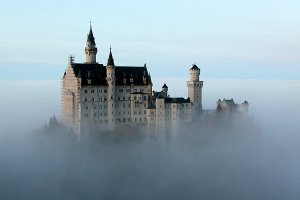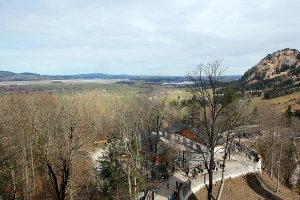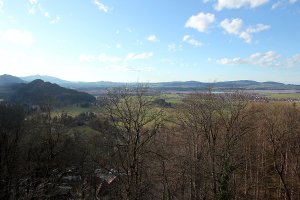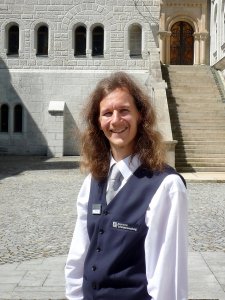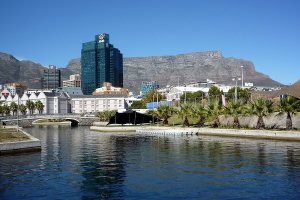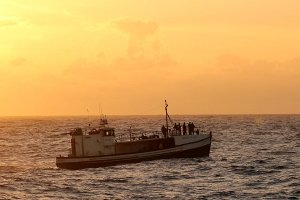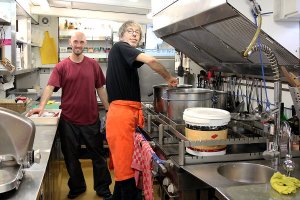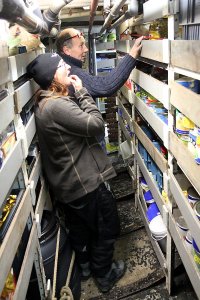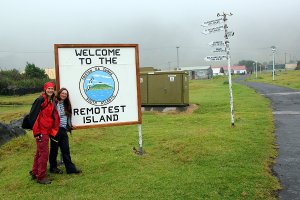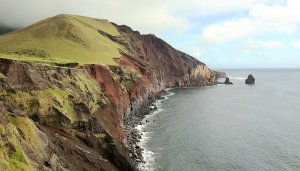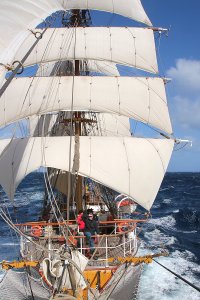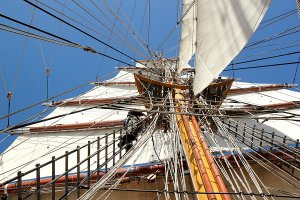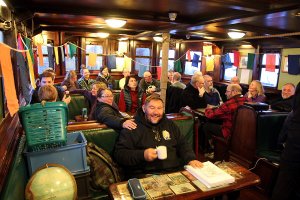Arto's Blog
Pages: << 1 2 3 4 5 ...6 ...7 8 9 10 11 12 ... 27 >>
A job with a royal view
Posted: 2016-07-03 01:47:00, Categories: Travel, Work, Germany, 878 words (permalink)Since March 2016 I've been working part-time as a guide at the Neuschwanstein castle, one of the most popular tourist attractions in Germany. It has been a great experience to do something completely different than my previous jobs, and the view out of the "office" windows is the best I've ever had. :-) In addition to greeting thousands of visitors from around the world, through the work I've gotten to know many nice colleagues, some even from the same village we are living in.
The castle is located a good 10 km from our apartment, on top of a hill so we actually see it from our windows. It takes me about 50 minutes to cycle there and change my clothes to the official outfit of the guides. I work normally on Mondays and Wednesdays, starting at 8, 9 or 10 in the morning, and finishing between 16:30 and 19 in the evening. During July-September I'll be there one more day per week, usually Thursdays. Additionally I'm still involved in IT projects on a freelance basis, so this year has been busier than usual.
With more than a million visitors per year Neuschwanstein is the top tourist magnet of the area. All visits of the castle are guided tours, which guarantees that there is enough to do. During the busiest time of the day, a new tour with up to 60 participants starts every 5 minutes. Every guide on duty does up to 10 tours a day, lasting about half an hour each. After the tour there's some time for answering questions, coming back to the starting point and preparing for the next tour, usually also for a short break in between. The tours come in three varieties: spoken tours in English and German, plus audio tours where each visitor gets a portable device and can choose the language from 18 alternatives. On an audio tour, the job of the guide is to lead the group through the castle, activate the audio guides at pre-defined points and help in case of any problems. That gives occasionally a chance to practise other languages than English and German. In addition to the tours, the guides are also responsible of cleaning the exhibition rooms. That's done every morning before the first tour starts. A world famous attraction brings in an international audience. One clearly visible trend is the rise of Chinese tourism: without any statistics in hand I'd guess that Chinese are already the second largest group of visitors right after Germans. Also other Asian countries, Northern America and large European countries such as France, Italy and Spain are well represented. Russians and East Europeans come often as well, and occasionally we receive South Americans too. Africans and Middle Eastern visitors are a rarity, even with Arabic offered as one of the languages on audio guide tours. A few times I've also met Finns in the castle. Neuschwanstein has more visitors and longer opening hours during the summer than in winter. Therefore they search guides for the summer season every year to complement the permanent staff, and that's how I also found the job. There is a range of different contracts available: full time, part time and a fixed number of days during the season, which suits especially students working during university holidays. I'm one of the three foreigners, the other two being Fabienne from France and Vladi from Slovakia. There are no dedicated English and German guides, we all do spoken tours in both languages as well as audio tours. My German isn't perfect, but being allowed to guide natives at one of the landmarks of Bavaria confirms that it's good enough.My contract is until the middle of November, a couple of weeks into the more quiet winter season. That means that I'll spend this summer and autumn mostly in Germany. One of my free time plans is to visit some other castles and palaces in the region. As an employee in one of the historic buildings managed by the state of Bavaria, there are quite a few others I have free entrance to.
The title photo shows Neuschwanstein five years ago, with the valley behind covered in fog, when I was visiting the area with my family. That was a magical moment, doing justice to the nickname "Märchenschloss", the fairytale castle. The other photos have been taken in spring 2016, featuring the view out of the windows of the guides' lounge, me at the castle courtyard and another view of the castle taken near the Marienbrücke bridge. The bridge is currently closed but should open again in August.Finally, a tip for everybody who'd like to visit the castle, especially on a summer weekend: come early in the morning. The first tour starts at 9 am, but the ticket center opens already at 8. Later in the morning you'll have to stand in the queue for quite a while, and in the afternoon all tickets for the day might even be sold out. Alternatively you can make a reservation in advance — there's a separate line to pick up pre-booked tickets. If you have a long waiting time before the beginning of the tour, a pleasant way to spend that is to take a walk along the shore of the nearby Alpsee lake.
From sailing to city life in Cape Town
Posted: 2015-12-21 03:06:00, Categories: Travel, Cycling, Art, Hiking, Sailing, South Africa, 1412 words (permalink)Welcome to the buffet
Posted: 2015-11-09 23:29:00, Categories: Travel, Ecology, Sailing, 587 words (permalink)Every day started with a breakfast buffet between 7 and 9 am, consisting of porridge, home made yoghurt, muesli, fruit pieces and fresh bread. The bread was baked every night and served with various toppings including cheese, ham, marmalades and peanut butter. Sometimes we also got eggs or other extras, and there were always juice, tea and coffee to drink.
At 1 pm we had lunch which included the soup of the day, another dish and a bread buffet similar to that on the breakfast. Dinner was served at 7 pm, starting with the main course and followed by a short break, during which everybody was eagerly looking forward to tasting the dessert of the day. During the dinner there were water, tea and coffee to drink. Soft drinks, beer and wine were available at the bar at extra cost. A couple of times a day small snacks were brought up to the deckhouse. To get a piece of cake or a cookie, it was essential to line up at the queue rather soon: in about ten minutes they were usually all gone. The most attractive serving of all was the fruit bowl, which appeared every two or three days. Using a combination of knowledge and gentle care, the kitchen team were able to offer even soft fruit such as peaches, plums and grapes for more than a month. During the last couple of weeks, soft fruit largely gave way to apples and oranges which keep longer, and they were in limited supply. Nevertheless, we had more fresh stuff than we thought when boarding the ship. The cook told us that experience from previous trips is used to estimate how much food is bought in, and will be needed at any given meal. For example during the days with landings the consumption is generally higher than during the days at sea. Whatever is left is cleverly recycled to throw away as little as possible. Leftovers of the dinner often reappeared next day at lunch, sometimes in a different form as pizza toppings or as ingredients of a dish baked in the oven. During long trips recycling is a necessity already due to limited storage capacity, but we also appreciated the ecological aspect of generating less waste.
Usually we ate inside, but occasionally when the sun came out and the sea was calm enough, the lunch was served out on the deck. The last photo shows our lunch buffet a couple of days before leaving South Georgia. That was one of our favourites, featuring three refreshing salads and crunchy pizza breads.
The small quiet island called Tristan
Posted: 2015-10-25 22:53:00, Categories: Travel, Sailing, Tristan da Cunha, 1045 words (permalink)On Easter Monday the 6th of April we visited Tristan da Cunha, a small volcanic island in the middle of Atlantic Ocean. It was our only stop on the way from South Georgia towards Cape Town, a welcome opportunity to have a short break from sailing and to walk on land again. After a friendly welcome at the port and the tourist info, the Tristanians offered a selection of guided tours to see the island in an organized way, but many also took the chance to wander around on their own for at least part of the day.
The first thing we noticed when walking across the settlement was quietness. We didn't hear the ocean any more, nobody was driving a vehicle or working in the garden, even most the dogs just looked at us and didn't bark. A few locals walked down the street and greeted us with a soft "Good morning", shortly breaking the silence when passing by. We looked at the houses on both sides of the street, painted in different colours and surrounded by small gardens, and thought about how it would be to live in one of them. The door to the village church was open, we entered and were greeted by the reverend who soon held a short morning prayer. Only some of us visitors were present, the Easter service to the local population had most likely taken place already earlier.
Tristan advertises itself as the remotest (inhabited) island in the world, which makes it an exotic tourist attraction. With no airport and only a handful of ships per year, it is still far from being overrun by visitors. For most of the time, the 300 inhabitants live there largely on their own, with only a small number of "outsiders" such as a veterinarian and a couple of scientists added to the mix. It is a community where land belongs to everybody and where rules are designed to prevent large differences in wealth between the inhabitants. Every family is entitled to have a potato patch, two cows, two sheep and a few chicken, and they generally work as farmers or fishermen. Except for the possibility to buy daily commodities in the supermarket or to have a drink at the pub, money plays little role in their daily life. Besides the income from tourism, Tristan exports lobsters and sells fishing licenses which bring in enough money to fit the houses with a reasonable level of modern comforts. The income is also used to import tractors, tools and other items which are needed, or desired, and cannot be produced locally.
The whole island consists of one big volcano with some flatter areas around it. In 1961 a side crater erupted right next to the main settlement and the whole population of Tristan da Cunha were evacuated. Unimpressed by the life in England, almost all returned two years later and resumed their simple life on the island. Nowadays, there is a trail leading to the crater, where we headed after crossing the settlement. It was an easy half an hour hike across the lava field, with already small patches of grass and other plants pushing out between the volcanic rocks. At the top, we had a nice view over the settlement, called Edinburgh of the Seven Seas, and the grass fields surrounding it. The main volcano reaches a height of 2063 meters, but of that we only saw the first few hundred meters, the rest being hidden in clouds.
After coming down from the volcano we took a peek in the supermarket, which was larger and better stocked than we had expected. Obviously it wasn't comparable to supermarkets in big cities, but there were certainly more things available than in supermarkets in small Chilean and Argentinian towns earlier during our trip, or at the village shop next to our house back home in Germany. Most of the supply was shipped from Cape Town, but there were also home made cake and fresh tomatoes grown on the island, both of which found place in our shopping basket.
We joined a short tour presenting the village museum, a traditional house showing how life had been on the island about 100 years ago. After the tour we wrote a few postcards and had sandwiches for lunch, complemented with fresh tomatoes and apples from the shop. Then we started walking on the only road leading out from the settlement, which ends at the potato patches a few kilometres away. We didn't get far before being offered a ride at the back of a pick-up truck driven by Marc, a French scientist working at the nuclear test monitoring station located on the island. The station is part of the worldwide network of stations, which control that the international treaty banning nuclear tests is respected.
The potato patches were, unsurprisingly, small patches of land with fences around, protecting the plants from cows and donkeys which were freely roaming on the grasslands around. We started walking back enjoying the green peaceful landscape and the sun which started to appear from behind the clouds. Closer to the settlement we diverged a bit from the road and walked to the edge of the cliffs by the sea. Judging from the view, we could well have been at the sea coast in Cornwall in South Eastern England. Perhaps that inspired also the first English settlers who started inhabiting the island 200 years ago.
Upon returning at the settlement, we had still a quick tour by Marc at the monitoring station, then it was time to step in the zodiacs and return to the ship. We wished we had been able to stay at least a few days, to meet more locals and to appreciate the island in an appropriate way without hurry. Unfortunately our ship had a schedule to meet and in the evening the wind was blowing from a favourable direction for our passage towards Cape Town. After a short swim in the ocean and a dinner we lifted the anchor and sailed away.
Sailing across the Atlantic
Posted: 2015-10-13 22:01:00, Categories: Travel, Sailing, 1273 words (permalink)Well remembering our struggles with seasickness during the last two legs of sailing, we tried a different medicine (cinnarizine) of which Bark Europa luckily had small reserves on board. And it helped! During heavy seas we still felt somewhat uneasy, particularly in areas under the deck without windows, but it was a big improvement to our earlier situation. Now we could take part in our work shifts normally, attend all lectures and actually enjoy the sailing. :-) A special thanks to mate Elskarin, who supported us earlier during the difficult times and arranged us the medicine which helped.
During clear nights we enjoyed a superb view of the Milky Way and hundreds of other stars above us. In the middle of the ocean there weren't any settlements nearby causing light pollution, and Bark Europa mainly had lights on only inside. We had guided stargazing sessions organized by Eduardo, who as an astronomy teacher had extensive knowledge of the stars and was enthusiastic about his topic. We learned to recognize some of the brightest stars and well known constellations on the southern hemisphere, the difference of a planet and a star, and to read from the sky in which direction the South Pole is — the most basic form of navigation. Most of the nights were, however, not clear, more typical weather was cloudy with occasional rain. Winds are often the strongest just on the border between high and low pressure weather systems, and that's what a sailing ship needs to get forwards. With the help of modern satellite connections, the captain downloaded a weather forecast every day and tried to find the most favourable winds for us. During the leg from South Georgia until Tristan da Cunha, the sailing was supported with the engine a few times, the last leg from Tristan to Cape Town was done exclusively on sails. Our typical speed was between 5 and 8 knots, or between 9 and 17 kilometres per hour. During good winds we could sometimes maintain an average of over 10 knots for several hours, but that needed a wind which was not only strong but also stable enough. In stable conditions an optimal amount of sails could be set, whereas during a weather including gusts of considerably higher force than the base speed of the wind, more sails had to be taken down to avoid breaking them. Despite that a few sails did break, that belongs to the life on a sailing ship. Of course the ship had spares and all necessary tools on board to carry out repairs on the way. Each day, we were two times four hours on watch, which consisted of work shifts at the lookout, at the helm (steering the ship) and of helping to set, adjust and take down sails when needed. That gave an opportunity to learn not only in theory but also in practise how the sails and the ship behave in different wind conditions. The general idea of how each sail is controlled with ropes was easy to grasp, but remembering which rope goes where needed considerable time and effort. Many didn't learn all the ropes even by the end of the voyage, which cannot only be blamed on our laziness but also on the quite complex arrangement of the ropes on Bark Europa. Nevertheless, most people did learn the most commonly used ropes, and how to handle a rope when it was assigned to them, which was enough to give a hand when the action was coordinated by a member of the permanent crew. Another task in sail handling was furling, which means tying the sails against their wooden stays when taking them down (to avoid unused sails catching wind), and respectively unfurling when setting the sails again. To do that it was necessary to climb up the masts, even until the top, in all weather conditions. The permanent crew took care of it in hard weather, otherwise we, the voyage crew, were encouraged to participate too. Nobody was forced to climb, it was done on a voluntary basis, as much as each person felt comfortable with. We had climbing harnesses to secure ourselves to metal wires, but it was still quite an adrenaline rush to climb high up when it was windy. And climbing up was of course not of any use in itself, you had to use your hands for tying and untying ropes instead of just holding tight to the nearest structure. My respect to the brave guys and girls who did that in the middle of the night in heavy rain. In beautiful, sunny weather we of course also climbed up the masts just for fun, to enjoy the view and to take photos. The lecture programs continued with new topics, including sailing and navigation, weather observations, ocean currents and ecosystems, our solar system and the universe, and Jordi's favourite, large seaweeds called kelp. The voyage crew were also encouraged to share their knowledge, which resulted in talks about quite a variety of themes, including being shipwrecked (Adam), the Falkland War (James), United Nations refugee work (Helen) and working in a missile silo (Glen). Additionally we watched some documentaries and movies, read books, played card games and had a few special events such as painting Easter eggs and a series of friendly competitions called the Ship's Olympics. So the answer to perhaps the most common question presented to us, "Won't you get bored on such a long sailing trip" is "No, there wasn't any risk of it." Every evening after dinner everybody gathered to the deckhouse to the "Eight o'clockie" hosted by the captain. He reviewed the last 24 hours of sailing, pointed our position on the map and showed the weather forecast for the upcoming night and day. Our guides continued with announcements and other general information everybody should know. Those were almost the only times we were all together. After the official part the bar was open and the deckhouse was the place to socialize, but many also returned to their cabins to sleep or read, had work shifts or something else to do. In the middle of the ocean there weren't as many animals around as near the coastline. Still, a few times we saw whales or dolphins, and some birds such as albatrosses and petrels flew to their fishing trips hundreds of kilometres off the land. The temperatures went up considerably after we left the cold Antarctic waters, but mostly we still needed a long sleeve or a jacket (or both) when being outside. There were times when a t-shirt was sufficient, but sunbathing on the deck with just bikinis on, the sailing ship smoothly gliding forwards in tropical waters, didn't happen on this voyage. We didn't mind, we had joined for an experience and an adventure, not a luxury cruise in the Caribbean.
Copyright Arto Teräs <ajt@iki.fi>, licensed under the Creative Commons Attribution-Share Alike 3.0 Unported License. (Unless otherwise mentioned in individual photos or other content.)
